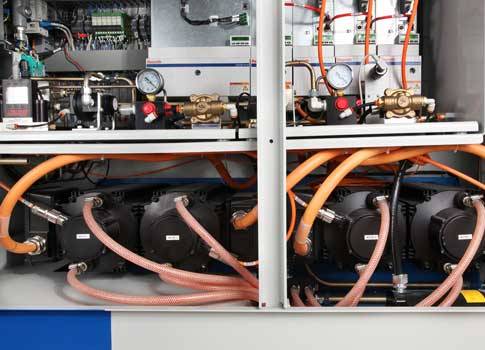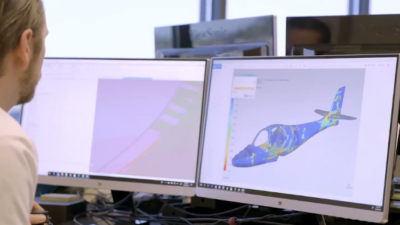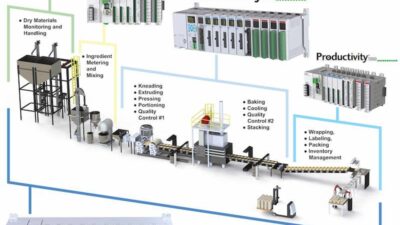Application Update: Shaken, not stirred: drives and controls enable novel, impeller-free acoustic mixing. Benefits include wider variety of mixing actions, fewer components, servo motor regeneration and near power factor unity for energy savings.

A new design for materials mixing creates benefits including a wider variety of mixing actions, fewer components, servo motor regeneration and near power factor unity for energy savings. Mixing is a critical step in creating everything from pharmaceuticals and cosmetics to rocket fuels. Traditionally, manufacturers have used a broad range of technologies to mix materials: stirring, using an impeller, extruders to blend materials, tumbling blenders to mix powders, etc., and the vigorous shaking most familiar in paint mixing. For many applications, these processes mix too unevenly for precise specifications, take long periods of time to mix, and require a plethora of hardware configurations and operating conditions to reach the desired product outcome.
Better alternatives exist, thanks to a novel mechanical resonance-based technology developed by an industrial engineering and design firm, Resodyn Acoustic Mixers. Resodyn Acoustic Mixers’ ResonantAcoustic Mixing (RAM) technique relies on low-frequency, high-intensity acoustic energy at nominally 60 Hz to fluidize the mix and create a phenomenon called acoustic streaming and micromixing within the material. RAM blends various types of materials in precise ways often unattainable by traditional methods, while avoiding the purity- and safety-related drawbacks of using impellers or blades. RAM technology is also much faster than traditional mixing and has also mixed materials where conventional mixers have failed.
The unique RAM process requires exceptional control of the machine’s powerful electric motors and drives, which produce resonant acoustics by spinning pairs of offsetting eccentric masses. By changing the phase angle of the offset between the pairs of eccentrics, the amplitude of the shaking of the mixing chamber is controlled. The vibration generated causes the mixture to interact in tune with the container producing the fluidization that permits even mixing throughout. Taking the motors in and out of phase with each other can create accelerations up to 100 g and results in an almost unlimited number of mixing actions.
RAM 5: The next generation
Resodyn recently decided to upgrade its RAM 5 resonant mixing platform, which was limited to volumes of approximately 5 gal., to a recently launched 55-gal. version, extending RAM technology’s inherent advantages.
“We had a great concept, and we wanted to take it to the next level where we could control the machine’s production time, cost, and complexity while saving our customers as much energy as possible during mixing,” said Resodyn senior engineer Brian Seaholm. Resodyn also wanted to avoid increasing the RAM 5 footprint (35 sq ft); the goal was to extend machine capabilities, not its size or intricacy.
Resodyn’s first priority was to streamline the machine: limiting the number of machine components, reducing communications cabling, and improving the machine’s control capabilities. But that would mean updating and simplifying the RAM 5 programming and communications protocols. And because RAM 5 operation depended on a unique Resodyn “black box” computer, multiple communications protocols would be required between the computer and the RAM 5 drives and motors.
To meet the challenge, Resodyn called upon a capable, experienced machine control provider that had supplied electric drive technology to the first generation RAM 5. And, as Seaholm said, that precise synchronization of RAM motors is needed, since speed and angle are constantly changing. “That’s important because maintaining resonance, an enabling feature of the RAM technology, requires precise control of different specific vibration frequencies, and because uncontrolled resonance can do serious damage to the machine itself.”
Resodyn also teamed up with well-established fabricator Northwest Motion, which has the machine programming background needed to handle multiple communications protocols. That company had previously helped another client create a cement mixer using similar resonant technology.
New drive and controls
The first step in updating the RAM 5 was selection of digital intelligent servo drives, which integrate a modular power supply unit and drive system, and offer regenerative power capabilities to divert kinetic energy from the machine’s servo motors back to the ac line. That way, excess power could generate energy instead of excess heat as the unit instantly shifts from consuming power to producing it. The drive platform provides a compact solution, and Resodyn knew it was ideal for motors in this multi-axis system. The drive supports the multiple communication protocols to communicate between the RAM’s black box and interface PC.
The servo drives were married with four liquid-cooled, high-speed rotary motors with maximum speed of 11,000 rpm. They synchronize the eccentric masses in two pairs, to impart force to the RAM system. “That combination gives Resodyn excellent power and a relatively small footprint,” said Patrick O’Connell, Northwest Motion’s regional motion control specialist.
Multilingual motion control
The next step was to ensure a smooth “conversation” between the communications languages and protocols controlling RAM 5 mixing. A programmable logic controller (PLC) is embedded in the drive for added simplicity and reduced fabrication time and costs. This PLC is specifically designed for open automation and flexibility of communication design, ideal for a machine that would require multiple protocols.
Components are controlled and synchronized “in conjunction with our own computer controls, and their PLC supported this,” said Seaholm. “So the biggest factor in making everything work was the programming skill and experience” of those involved in the project.
The team chose SERCOS III for the main bus to keep the drives synchronized for exact positioning. Control between the Resodyn “black box,” the RAM’s PC, and the master drive relies on OPC Server and RS232, sensing and responding to minute changes in the resonant condition. Encoder emulation allows the drives to report back to the “black box.” Interestingly, machine control and I/O rely on analog signals as well as digital, with an analog link between the “black box” and the drives as well. According to Seaholm, this not only helped keep mixing within demanding specs, but was also important for recipe-based operation, with the operator inputting complete acceleration setpoint and timing instructions at the start of each job depending on the mixture. Finally, an Ethernet-based OPC Server connects the operator to the embedded PLC via the PC-based HMI.
Harmonious partnership
For controls, component engineering, programming code, and communications, engineers wrote sample code for machine setup and testing. The cooperative effort created “benefits customers want—and at a competitive price,” said Seaholm, who estimates that the drive-based platform reduced each RAM unit’s electronics costs by thousands of dollars. These savings have carried forward to the newly launched Resodyn RAM 55 technology.
Big user advantages
Advantages include impressive benefits, including more precise, even mixing; mixing at various scales, which include macroscopic, microscopic, and even down to the molecular levels; and cleaner, more reliable operation. RAM mixing makes it easier for manufacturers to meet strict pharmaceutical or cosmetics regulations, since there’s no impeller to keep clean and no need to open chemical containers for mixing. Seaholm notes that the RAM 5 produces huge time savings over traditional mixing—reducing one application from hours to minutes—and that recipe-based input makes it easier for end-users to switch parameters between each mixing job. Finally, users benefit from the drive regenerative advantage and near power factor of unity, substantially reducing energy costs.
“We can help manufacturers get a competitive edge,” Seaholm said. And with the super-sized RAM 55 in the wings, Resodyn is poised to shake up the world of industrial mixing.
Challenges, solutions
- Achieve precision timing to take motors in and out of phase during mixing to create resonance at exactly the right frequency, producing the fluidization that allows for even mixing and a virtually limitless number of mixing actions
- Blend multiple programming languages for communication between drives, motors, embedded PLC, and Resodyn “black box” controller
- Simplify machine construction, reduce cabling and production time
- Reduce machine production cost
- Maximize energy efficiency.
Results include:
- Precision mixing for wide range of materials within demanding specifications and tolerances
- Considerable machine production cost savings
- Substantial energy savings from regenerative drives
- Huge reduction in mixing time (from hours to minutes in many cases)
- Drive and control platform established for larger RAM 55 mixer.
– Edited by Mark T. Hoske, content manager, CFE Media, Control Engineering, Plant Engineering, [email protected].
ONLINE
www.boschrexroth-us.com
Northwest Motion www.nwmotion.com



